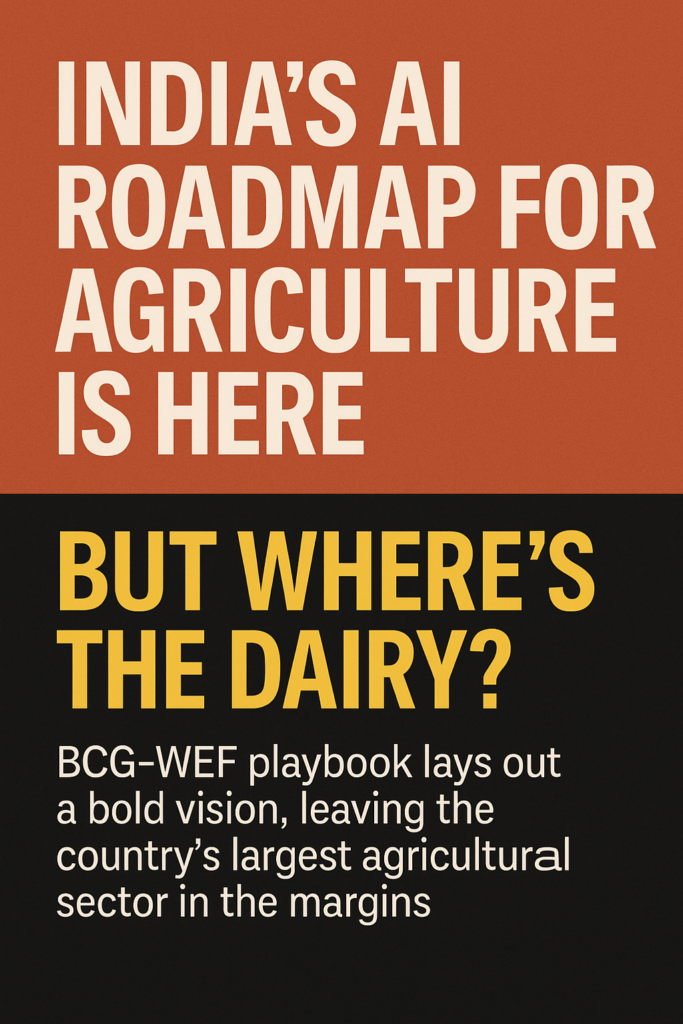BCG–WEF Playbook Lays Out a Bold Vision, Leaving the Country’s Largest Agricultural Sector in the Margins
By Dairy Dimension Editorial Desk
📅 June 2025
🧭 Executive Summary
The Future Farming in India report, released in February 2025 by the World Economic Forum and BCG, outlines an ambitious strategy to transform Indian agriculture through the use of Artificial Intelligence (AI). Built around real-world pilots and expert consultations, it presents an “IMPACT AI” framework—Enable, Create, Deliver—designed to scale AI across farming practices. The report identifies key AI use cases, ranging from crop planning to soil health and pest control, and stresses the importance of inclusive ecosystems.
However, one critical sector is notably absent from the discussion: the dairy industry.
India’s dairy sector contributes more than 5% of the national GDP, sustains over 80 million rural households, and accounts for one-third of agricultural GVA—yet it finds no meaningful mention in this playbook.
This article analyses the key findings of the report, draws favourable inferences for dairy, assesses where AI in dairy has struggled, and outlines strategic interventions to close the gap.
📘 Key Findings from the Report
The Future Farming in India playbook outlines the following:
-
AI has the potential to boost yields, lower input costs, and improve farmer profitability
-
Four core use cases were highlighted:
-
- Macro Crop Planning using market, climate, and soil data
- Rapid Soil-Health Analysis through spectroscopy and AI
- Pest Prediction and Control via AI models and remote sensing
- Smart Marketplaces that digitise price discovery, quality, and demand forecasts
-
An IMPACT AI framework was developed:
- Enable: Governments to build digital infrastructure and data governance
- Create: Startups and innovators to develop and test AI solutions
- Deliver: Extension systems to ensure last-mile adoption
-
The framework is aligned with India’s AgriStack, IndiaAI Mission, and state-led AI initiatives.
Despite rich technical detail, dairy—the largest agri-subsector—is absent from the playbook’s focus areas.
✅ Positive Inferences for the Dairy Sector
While dairy isn’t explicitly addressed, the crop-focused strategies can be reimagined for dairy transformation:
1. AI-Enabled Marketplaces → Smart Milk Pricing & Traceability
- What the report says: Use AI to digitise crop trading with real-time pricing, quality grading, and digital payments.
- Dairy Inference: AI models can power dynamic milk pricing, digital quality grading (fat/SNF), and predict demand.
Examples:
- Stellapps’ MooPay digitises milk payments.
- AgNext’s Qualix uses spectroscopy and AI for instant milk quality testing.
🟢 Stellapps reports 30–40% increase in farmer payouts in digital pilot zones.
🔴 No national dairy marketplace exists, unlike eNAM for crops.
2. AI Crop Planning → Breeding & Lactation Optimisation
- What the report says: Use AI to recommend crops based on weather, soil, and market signals.
- Dairy Inference: Breeding cycles and calving windows can be optimised using AI with heat stress, fertility, and nutrition data.
Examples:
- Chitale Dairy uses AI to improve breed productivity.
- NDDB’s e-Gopala offers basic decision tools.
🟢 AI-enabled breeding has reduced feed costs per litre.
🔴 Most FPOs rely on manual records; AI uptake is limited.
3. Soil Health Spectroscopy → Feed Quality Testing
- What the report says: AI-powered soil testing informs nutrient management.
- Dairy Inference: Replace soil with feed—AI can assess silage, fodder, and TMR quality using NIR and image analysis.
Examples:
-
Krimanshi, eFeed, and Prompt Equipments are piloting AI-linked feed sensors.
🟢 Potential to prevent nutrition-related yield drops.
🔴 Lack of a national “fodder database” like AgriStack.
4. Pest Surveillance → Disease Detection in Dairy Animals
- What the report says: AI models predict pest attacks using environmental data and images.
- Dairy Inference: Image-based tools can help identify mastitis, FMD, and fertility issues. AI models can monitor milk conductivity and behaviour.
Examples:
- e-Gopala offers disease tracking but lacks AI capabilities.
- Vision-based disease detection is utilised in the European Union.
🟢 Machine learning can improve early animal health response.
🔴 India lacks a centralized AI animal health surveillance model.
🔍 Where AI in Dairy Has Struggled
| Area | Tools Available | Challenges |
|---|---|---|
| Breeding Optimization | e-Gopala, ABS tools | Lacks integration with AI models; poor UX adoption |
| Milk Quality Assurance | Qualix, FTIR, Ultrasonic testers | High cost; not scaled beyond pilots |
| Animal Health Monitoring | Manual logs, basic mobile apps | No AI-based alerts; limited field adoption |
| Financial Services | Milk-based lending pilots | Banks don’t trust milk records; credit models are missing |
| Traceability | Chilling center data logs | No national traceability chain (unlike eNAM or e-FPO stack) |
🎯 Strategic Recommendations
1. Build a “Smart Dairy Stack”
- Modelled on AgriStack, but focused on livestock.
- Should include datasets on milk yield, breed history, animal health, payment cycles, and fertility records.
2. Establish an AI Sandbox for Dairy
-
Enable private players to test AI solutions for milk testing, disease alerts, feed diagnostics, and breeding tools in a regulated environment.
3. Develop Regional Milk Intelligence Platforms
-
Guide procurement, chilling infrastructure, logistics, and pricing strategies, just like regional crop models.
4. Empower Extension with AI Tools
-
Train vets and field staff to deliver AI-generated insights: calving forecasts, heat stress warnings, mastitis risk, etc.
🧩 Final Word
India’s AI vision for agriculture is bold, well-structured, and timely. But it omits dairy at a time when AI tools for milk quality, breed optimisation, feed intelligence, and disease management already exist.
The good news? The blueprint is adaptable.
Stakeholders—NDDB, MeitY, ICAR-NDRI, dairy startups, and cooperatives—must now co-develop a dairy AI roadmap that complements the national Agri-AI mission.
“Ignoring dairy in AI frameworks is not just a policy gap—it’s a strategic misfire. Milk is India’s largest crop.”
– Prashant Tripathi, Jordbrukare India
